
Minivan is a North American car classification for vehicles designed to transport passengers in the rear seating row(s), with reconfigurable seats in two or three rows. The equivalent classification in Europe is the M-segment, more commonly known as an MPV or a people carrier / mover. Minivans often have a 'one-box' or 'two-box' body configuration, a higher roof, a flat floor, a sliding door for rear passengers, and high H-point seating.
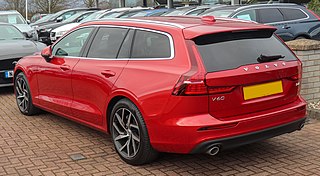
A station wagon, also called an estate (UK) or simply wagon (US), is an automotive body-style variant of a sedan/saloon with its roof extended rearward over a shared passenger/cargo volume with access at the back via a third or fifth door, instead of a trunk/boot lid. The body style transforms a standard three-box design into a two-box design — to include an A, B, and C-pillar, as well as a D-pillar. Station wagons can flexibly reconfigure their interior volume via fold-down rear seats to prioritize either passenger or cargo volume.

A hatchback is a car body configuration with a rear door that swings upward to provide access to a cargo area. Hatchbacks may feature fold-down second row seating, where the interior can be reconfigured to prioritize passenger or cargo volume. Hatchbacks may feature two- or three-box design.

Coupé de ville — also known as town car or sedanca de ville — is a car body style produced from 1908 to 1939 with an external or open-topped driver's position and an enclosed compartment for passengers. Although the different terms may have once had specific meanings for certain car manufacturers or countries, the terms are often used interchangeably.

The Lincoln Continental is a series of mid-sized and full-sized luxury cars produced by Lincoln, a division of the American automaker Ford Motor Company. The model line was introduced following the construction of a personal vehicle for Edsel Ford, who commissioned a coachbuilt 1939 Lincoln-Zephyr convertible, developed as a vacation vehicle to attract potential Lincoln buyers. In what would give the model line its name, the exterior was given European "continental" styling elements, including a rear-mounted spare tire.
There are many types of car body styles. They vary depending on intended use, market position, location and the era they were made in.

The Ford Bronco is a model line of sport utility vehicles manufactured and marketed by Ford. The first SUV model developed by the company, five generations of the Bronco were sold from the 1966 to 1996 model years. A sixth generation of the model line is sold from the 2021 model year. The nameplate has been used on other Ford SUVs, including the 1984-1990 Ford Bronco II compact SUV and the 2021 Ford Bronco Sport compact CUV.

Power door locks allow the driver or front passenger to simultaneously lock or unlock all the doors of an automobile or truck, by pressing a button or flipping a switch.

The trunk or boot of a car is the vehicle's main storage or cargo compartment, often a hatch at the rear of the vehicle. It is also called a tailgate.

The Renault Avantime is a grand tourer marketed by the French manufacturer Renault, designed and manufactured by Matra, between 2001 and 2003. As a one-box design without B-pillars, styled by Patrick Le Quément, the Avantime combined the design elements of an MPV, estate or shooting brake with the style of a 2+2 coupé and elements of a convertible.
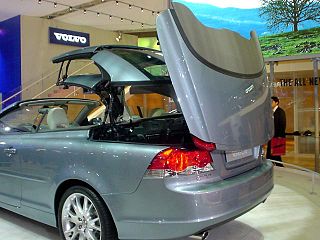
A retractable hardtop — also known as "coupé convertible" or "coupé cabriolet" — is a car with an automatically operated, self-storing hardtop, as opposed to the folding textile-based roof used by traditional convertible cars.
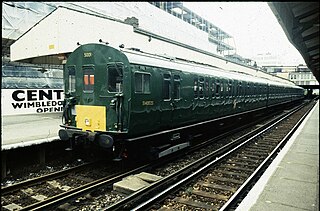
British Rail Class 415 was a suburban 750 V DC third rail electric multiple unit commissioned by the Southern Region of British Railways. Built between 1951 and 1957, it became the most numerous class on the region after the withdrawal of the 4SUBs. The final trains were withdrawn in the 1990s, replaced by Class 455, 456, 465 and 466.
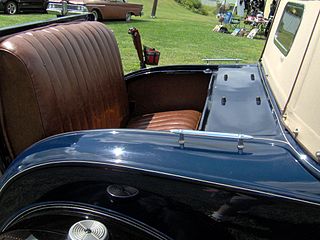
A rumble seat, dicky (dickie/dickey) seat, also called a mother-in-law seat, is an upholstered exterior seat which folded into the rear of a coach, carriage, or early motorcar. Depending on its configuration, it provided exposed seating for one or two passengers.
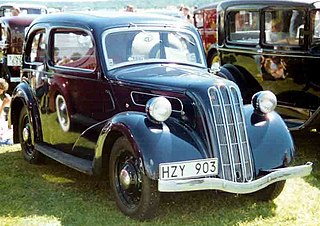
The Ford 7W Ten is a car built by Ford UK between 1937 and 1938.

The DRG Class ET 85 was a German electric motor coach with the Deutsche Reichsbahn and, later, the Deutsche Bundesbahn.

A compartment coach is a railway passenger coach divided into separate areas or compartments, with no means of moving between compartments.
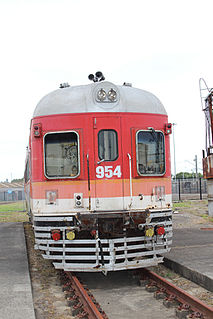
The 900/800 class railcars were Diesel Multiple Units built by the New South Wales Government Railways between November 1951 and November 1960.
Toyota concept vehicles produced between 1935 and 1969 include:

The RUB type carriage stock was a type of steel bodied air conditioned passenger carriage operated by the New South Wales Government Railways from September 1949 until April 2000.
The PL type carriages were a series of 141 wooden passenger carriages used on the railways of Victoria, Australia. They consisted of the first class APL, second class BPL and combination second and guard's van, BCPL's.
















